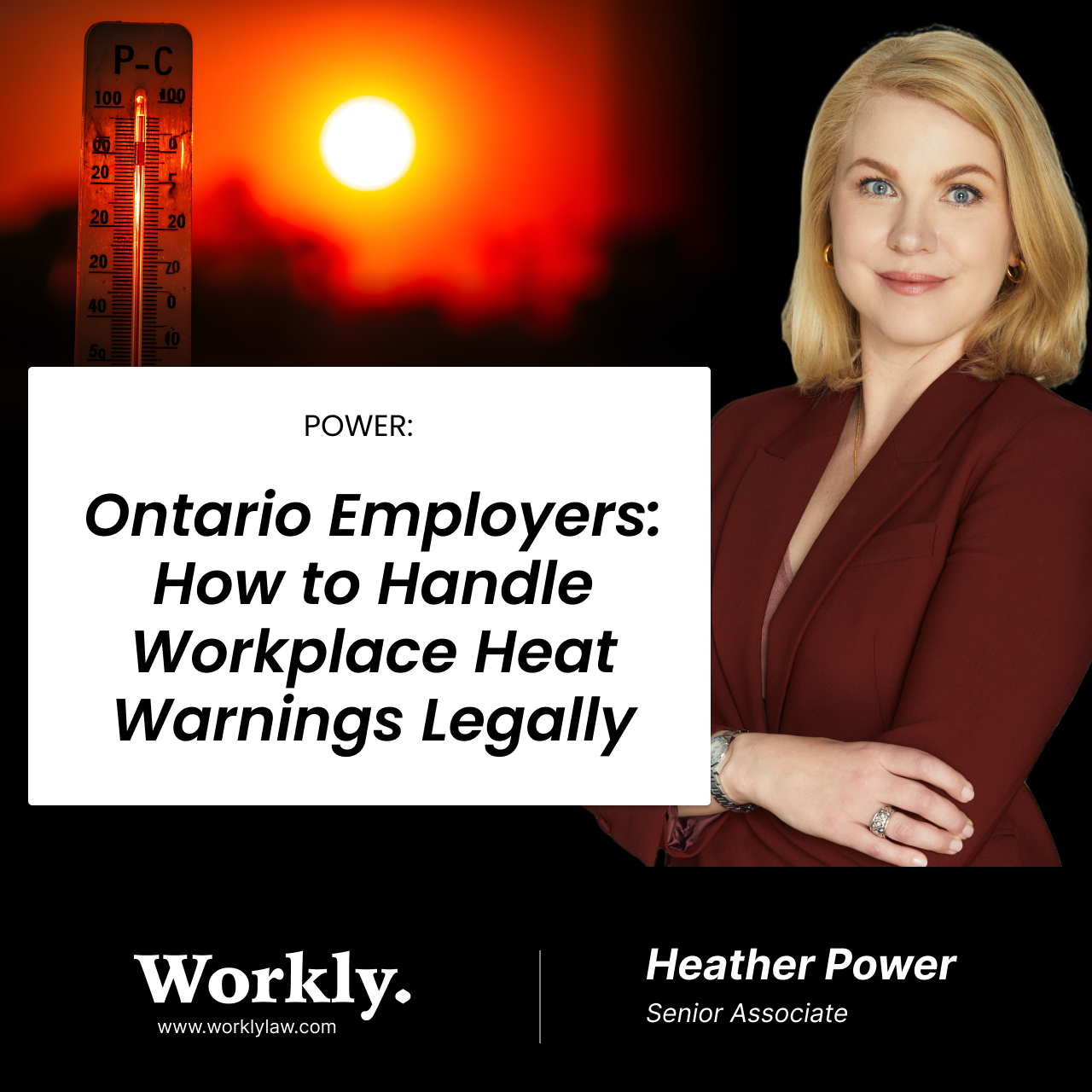Heather Power
Ontario Employers: How to Handle Workplace Heat Warnings Legally

Learn how to meet your obligations and keep workers safe during extreme heat events. Practical advice for employers managing outdoor and indoor workplaces.
As summer temperatures in Canada continue to rise due to climate change, heat warnings in Ontario are becoming increasingly common. For employers, these warnings aren't just uncomfortable —they raise serious legal and safety considerations under Ontario's Occupational Health and Safety Act (OHSA).
Extreme heat can pose significant risks to worker health and safety, including heat exhaustion, heat stroke, and other heat-related illnesses. These hazards are particularly acute in outdoor workplaces such as construction sites, landscaping, agriculture, and road work, but also affect indoor environments like warehouses, factories, and kitchens that lack proper ventilation or climate control.
This article outlines what Ontario employers need to know about their legal obligations under OHSA during heat warnings, and offers practical guidance for reducing liability and, more importantly, protecting workers.
Legal Obligations Under OHSA
Under Ontario’s Occupational Health and Safety Act, employers have a general duty to take every precaution reasonable in the circumstances for the protection of a worker (OHSA, s. 25(2)(h)). This duty includes protecting workers from known environmental hazards such as heat stress.
While there is no specific regulation under OHSA that sets maximum workplace temperatures, the Ministry of Labour, Immigration, Training and Skills Development (MLITSD) expects employers to take proactive steps to assess and mitigate heat-related hazards.
Employers are also required to:
-
Provide information, instruction and supervision to protect workers (s. 25(2)(a));
-
Acquaint workers with workplace hazards (s. 25(2)(d));
-
Have a functioning Joint Health and Safety Committee (JHSC) or Health and Safety Representative, depending on the size of the workplace, which must be involved in hazard assessment and mitigation;
-
Implement measures in compliance with applicable standards, including those referenced in sector-specific guidelines and industry best practices.
In addition, the Internal Responsibility System (IRS) under OHSA encourages all workplace parties—including supervisors and workers—to participate in health and safety efforts.
Employers cannot shift responsibility for managing heat-related risk to workers alone.
Understanding Heat Stress and Heat Warnings
Heat stress occurs when the body is unable to cool itself sufficiently, resulting in increased internal temperature. Symptoms range from rash and cramps to more severe conditions like heat exhaustion and potentially fatal heat stroke.
In Ontario, Environment Canada issues heat warnings when forecasted temperatures or humidex values are expected to be high enough to pose health risks. For example:
-
Daytime temperatures of ≥31°C and nighttime temperatures of ≥20°C, or
-
Humidex values of ≥40 for two consecutive days.
Employers should monitor these alerts regularly through the Environment Canada website or local public health units, and be prepared to act when warnings are issued.
Practical Tips for Heat Hazard Prevention
While the law does not prescribe exact temperatures at which work must stop, employers should treat heat warnings seriously and be diligent about heat related worker safety. Below are practical steps to help meet your legal obligations and reduce risk:
-
Conduct a Heat Stress Risk Assessment
Identify areas or roles in the workplace where employees are at high risk due to:
-
Direct sunlight or outdoor exposure;
-
Hot indoor environments (e.g., ovens, machinery);
-
Heavy physical exertion;
-
Inadequate air flow or ventilation; OR
-
Workers wearing personal protective equipment (PPE) that retains heat.
Your JHSC or Health and Safety Representative should be involved in evaluating risks and recommending controls.
-
Implement a Heat Stress Control Plan
A written heat stress control plan aims to minimize or eliminate the risk of heat-related illness in the workplace.
A heat stress control plan should include the following:
-
Procedures for monitoring temperature and humidity;
-
A plan for reducing workload during peak heat (e.g., scheduling heavy tasks in early morning, increasing the frequency of breaks during heat alerts);
-
Mandatory rest breaks in shaded or air-conditioned areas;
-
Encouragement of frequent water intake;
-
Buddy systems or other measures for monitoring workers for heat-related illness symptoms; and
-
Protocols for responding to signs of heat-related illness.
Resources for developing a plan are available through the MLITSD and the Canadian Centre for Occupational Health and Safety (CCOHS).
-
Train and Educate Workers and Supervisors
Ensure all supervisors and workers are trained on the following:
-
The signs of heat stress;
-
How to stay hydrated and cool;
-
The importance of rest and recovery;
-
How to report concerns or symptoms;
Supervisors should be trained to recognize early signs of heat-related illnesses and to act immediately if symptoms occur.
-
Provide Cooling Infrastructure and Supplies
Where possible, employers should:
-
Provide fans or air conditioning in indoor spaces;
-
Provide shaded areas outdoors;
-
Offer cool drinking water (and electrolyte beverages if appropriate);
-
Adjust PPE or clothing requirements where possible (without compromising safety);
-
Allow for flexible work arrangements during heat waves; and
-
Allow for increased frequency of breaks during heat waves, which may require measures such as scheduling additional workers to ensure coverage over breaks.
Special Considerations
Young and New Workers
New or young workers may be less aware of heat risks. It is important to ensure adequate training and supervision during the hot season for all employees, including summer students and temporary workers.
Vulnerable Employees
Some workers may have pre-existing medical conditions, be on medications, or observe fasting periods (e.g., for religious reasons) that make them more susceptible to heat stress.
In addition to the OHSA health and safety obligations above, employers should accommodate these workers under the Ontario Human Rights Code where appropriate.
Unionized Workplaces
Employers should also check collective agreements for any provisions related to heat exposure, rest periods, or extreme weather protocols.
Enforcement and Liability
The MLITSD can and does investigate heat-related incidents. Failure to comply with OHSA duties—particularly the general duty to protect workers—can result in:
-
Orders to improve conditions,
-
Stop work orders,
-
Monetary penalties, and
-
Prosecution with significant fines (up to $2 million for corporations and $500,000 for individuals, plus potential jail time).
More importantly, serious or fatal heat stress incidents can cause lasting harm to workers and reputational damage to employers.
Final Thoughts
As extreme weather becomes more common in Ontario, managing heat risk is no longer just good practice—it’s a legal and ethical necessity.
Employers should not wait for a tragedy or an order from the MLITSD to take action. A proactive heat stress strategy protects not only your workers but also your business from liability, reputational damage, and operational disruption.
If you haven’t already, now is the time to review your health and safety policies, engage your JHSC or health and safety representative, and implement a robust response to workplace heat warnings for your workplace.
Need help developing a heat stress control plan or training supervisors and workers on heat-related hazards and protection? Workly Law is happy to assist.
Stay compliant. Stay safe. Stay cool.
This article is for informational purposes only and does not constitute legal advice. For guidance specific to your workplace, consult legal counsel.
Related articles
POWER: Ontario Minimum Wage Increase Effective October 1, 2025
Effective October 1, 2025, Ontario’s general minimum wage will increase to $17.60 per hour (up from $17.20). This annual adjustment is tied to the Consumer Price Index and affects nearly all employees covered by the Employment Standards Act, 2000 (ESA). For employers, this increase is a timely reminder to review pay practices, budgets, and compliance processes before the fall.
CHAUDHRI: Employer conduct sanctioned by Ontario court
Courts do not want employees to be 'starved' by employers in an effort to have them accept lower packages on termination


